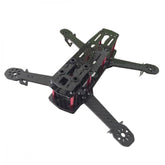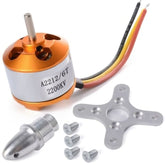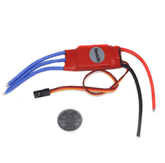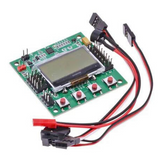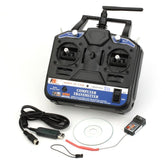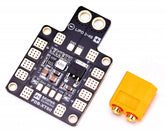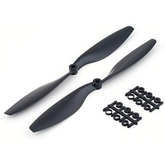Getting started with a Quadcopter
Summary
Are you ready to take flight into the thrilling world of quadcopters? Our blog, "Getting Started with a Quadcopter," is your ultimate guide to soaring above the clouds. In the introduction, we'll pique your curiosity about the wonders of quadcopters. Discover the heart and soul of these magnificent machines as we delve into the components of a quadcopter.
But wait, it gets even better! Our step-by-step guide will walk you through the exhilarating journey of building your very own drone from scratch. Whether you're a beginner or a seasoned enthusiast, we've got you covered. Finally, in the conclusion, we'll sum up the excitement and possibilities that await you in the world of quadcopters. Get ready to elevate your perspective – your adventure begins here!
Introduction
People who love drones certainly love quadcopters. For those who are not aware, a Quadcopter/Quadrotor is a Drone with four motors and propellers. Like any other drone, a Quadcopter is amazing and a must-have if you are into flying drones. But Quadrotors or Drones, in general, are a bit expensive. But what if you could build your custom quadcopter, at a price lesser than what you can purchase one for? Sounds Interesting right? Here’s how one can go about building their Quadcopter from Scratch.
Before we start with building the drones, it is important to know that there are mainly two ways of operating the drones : -
1. Line of Sight Control
2. First-person view.
First-person view uses an FPV camera mounted on the drone to give the drone pilot a view directly from the perspective of the drone served through FPV goggles. Line of sight control is when the drone pilot maintains line of sight view with the drone in order to fly it around. Here we will discuss a simple drone that can be easily be operated in line of sight mode
Visit our DIY Drone Kits collection page for 4K HD Camera and accessories.
Components of a Quadcopter
1. Frame:
The skeleton of the quadcopter is made by the frame. It is that part of the drone on which different components get mounted. Depending on your need there are various types of drone frames available in the market that are made with different materials like plastic, glass fiber, PCB, or even wood. It depends on the budget and the application for which the drone is being built. Frames made using fragile material will tend to break easily in a crash and may not sustain heavier motors and batteries.

HSKRC QAV250 RC Drone Frame Kit
Given above is a basic Quadcopter Carbon Fiber Frame that can be used to build your quadcopter drone
2. Motor:
Motor is the most essential part of your QuadCopter/Drone. Motors rotate the propellers which in turn generate lift. Depending on the Frame size, a drone motor can be chosen. BLDC motors have different ratings. The Kv rating of a BLDC motor is the ratio of its unloaded RPM to the peak voltage. If you buy a similar frame as mentioned above the most ideal motor will be the 22-23xx Series.
read more : Drone Motor – Where to Begin?

A2212 2200Kv Brushless Outrunner Motor Aircraft Quadcopter Helicopter
3. ESC or Electronic Speed Control:
The Electronic Speed Control (ESC) is essential for DIY drone builds. It's the component that controls the power output and speed of drones' motors, giving users full control during flight. With a professional-grade ESC, you get powerful performance with smooth acceleration and precise throttling capabilities to give your projects an edge over competitors. ESCs also boast active braking protection against sudden mobility changes or stalling from incorrect throttle inputs while in motion so your motor does not suffer any damage as a result of user mistakes!
read more : How to Choose ESC for Quadcopter

Simonk Red ESC 30A for Quadcopter
4. Flight Controller (FC):
A flight controller is the most integral part of the drone/quadcopter. It allows the drone to be controlled by the user by translating roll, pitch, yaw and thrust inputs from the radio controller into ESC signals thereby controlling the motors. It also has onboard accelerometers and gyroscopes allowing for it to hover the drone autonomously without user input.
read more : Best Flight Controller for Drone

KK 2.1.5 Multi-Rotor LCD Flight Control Board
5. Radio Transmitter and Receiver:
The DIY Drone Radio Transmitter and Receiver makes it easy to set up your own drone. They pair quickly with no complicated setup, so you can get flying in minutes. The receiver offers full-range control independently of other RC systems through its user-programmable frequency selection capability. It includes advanced failsafe features like remote low voltage detection, signal loss protection and variable range measurement for greater accuracy in navigation tasks when using multiple drones simultaneously. The transmitter's intuitive interface design as well as a comprehensive list of functions such as dual rates, expo settings and channel mixing will help you build customized control surfaces that suit your desired performance requirements perfectly!
read more : Drone Transmitter and Receiver Guide

FlySky FS-TH9X 2.4G 9CH Transmitter
6. Power Distribution Board:
Normally a Flight Controller has a PDB, but if not, you would need a PDB to help your Quadcopter/Drone handle all levels of power. The PDB also handles the connection to the Battery. Normally your drone would need at least 4 high-power connections for Electronic Speed Control and a few others for FC and Receiver.

7. Propeller:
Propellers are the fans that make your drone fly, by moving in clockwise and anticlockwise directions the propellers help a drone to move and attain height.
read more : Choosing the Right Propellers for Your Drone

Quadcopter propellers 10 x 4.5 (1 Pair)
8. Battery and Charger:
A Lithium Polymer Battery can be used to power your Quadcopter. Depending on the specification of the ESC, motor a suitable battery can be chosen, the LiPo Battery comes with the Charger, so the Power when it runs out can be charged in again.
read more : Affordable Drone Batteries

Step By Step Guide to Build your Drone:
Step 1: The Frame can also be made at home, but we need to consider mounting options, so it's better to buy one. After you have a Frame ready with you, each motor will go into the endpoints of the Frame Structure for a quadcopter.
Step 2: After you have the frame ready with you, you need to mount the drone’s motors on each hand of the frame, it is preferable to buy a motor that comes with a mount that can be fixed on the quadcopter easily if you don't have the amount you need to ensure that the motor is fixed firmly on the drone hand. After you fix the Motors the propellers would go into the motors that are mounted on the ends of the Quadcopter.
read more : Assembling the DM002 Drone
By the end of this step your drone should look like this :

ref:Content.Instructables
Step 3: Attach the ESC to the bottom of the Drone Frame, in the frame link specified above there space to attach the ESC below the Drone, if ESC is attached at the bottom of the drone, then you have more space at top of the Drone to attach additional things too.
The ESCs are fixed to the hands of the Drones something like this

Fig 1
Step 4: Preferably Attach a Landing Pad to the Drones bottom, so that when the drone lands it absorbs the shock and damage to Quadcopter is Avoided
Step 5: Attach the Flight controller on the drone with a sponge beneath it, to lessen the vibrations coming from the drone. In fig 1 the flight controller is attached to the center of the Quadcopter.
Step 6: According to the Radio Receiver and transmitter you have and also the flight controller and ESC, you need to configure the ESC with the Flight Controller and the Drone with the Remote Controller. The ESC and Flight Controller you are using can be connected through watching tutorials of the same YouTube, it varies for different types of Parts you use.
read more : How to build a quadcopter drone at home
Conclusion:
Diving into the world of quadcopters has been an exhilarating journey. We began with a comprehensive introduction, unravelling the exciting possibilities of these flying marvels. We then dissected the essential components of a quadcopter, shedding light on the mechanics that make them soar. Finally, our step-by-step guide empowered you to embark on your very own drone-building adventure.
Now, with the knowledge and skills acquired, the sky truly is the limit! Whether it's for photography, exploration, or simply the thrill of flight, your quadcopter is poised to take you on incredible adventures. So, gear up, get flying, and let your imagination soar! The world of quadcopters awaits, and the journey has only just begun.
If you appreciate our work don't forget to share this post and leave your opinion in the comment box.
Please do check out other blog posts about Popular electronics
Make sure you check out our wide range of products and collections (we offer some exciting deals!)



